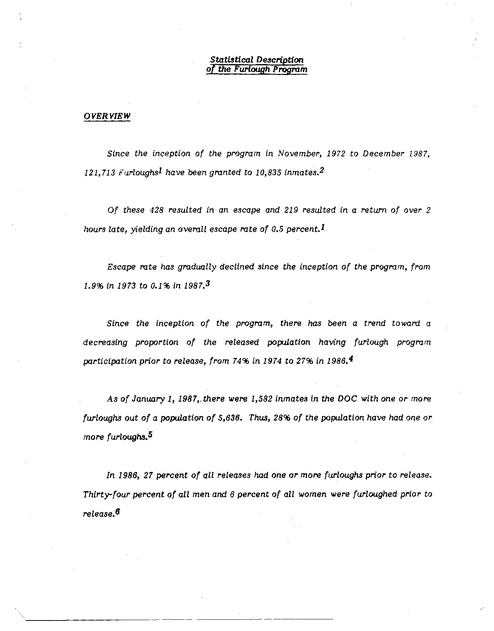Statistical Description of the Massachusetts Furlough Program 1972-1987
Download original document:

Document text

Document text
This text is machine-read, and may contain errors. Check the original document to verify accuracy.
Statistical Descrg;; of the Furlough P m OVERVIEW Since the inception of the program in November, 1972 to December 1987, 121,713 Fu.rloughsl have been granted to 10,835 inmates. 2 Of these 428 resulted in an escape and 219 resulted in a return of over 2 hours late, yielding an overall escape rate of 0.5 percent) Escape rate has gradually declined since the inception of the program, from 1.996 in 1973 to 0.196 in 1987. 3 Since the inception of the program, there has been a trend toward a decreasing proportion of the released population having furlough program participation prior to release, from 7496 in 1974 to 2796 in 1986. 4 . As of January 1, 1987,_ there were 1,582 inmates in the DOC with one or more furloughs out of a population of 5,636. Thus, 2896 of the population have had one or more furloughs. S In 1986, 27 percent of all releases had one or more furloughs prior to release. Thirty-four percent of all men and 6 percent of all women were furloughed prior to release. 6 FIRST-DEGREE LIFERS: Between 1972 and 1975, 792 furloughs were granted to first-degree lifers that resulted in 6 escapes, for an escape rate of 0.76 or 7.6 escapes per 1,000 furloughs. 7 Between 1976 and 1980, 2,328 escapes were granted to first-degree lifers and 2 escapes resulted, yielding an escape rate of 0.08 or .8 escapes per 1,000 furloughs. 8 Between 1981 and 1986, 2,434 furloughs were granted and 3 escapes resulted, yielding an escape rate of 0.12 percent or 1.2 escapes per 1,000 furloughs. 8 There is currently no information available on the furlough activity of firstdegree lifers during 1987. SECOND-DEGREE UFERS: From 1976-1980, 5,233 furloughs were granted to second-degree lifers and 12 resulted in an escape for an escape rate of 0.2296 or 2.2 escapes per 1,000 furloughs. 8 From 1981-1986 6,293 furloughs were granted to second-degree lifers and 9 resulted in an escape for an escape rate of 0.1496 or 1.4 escapes per 1,000 furl oughs. 8 A t this point no information is available on furlough activity for seconddegree lifers in 1987. Lifers in the Department of Correction: At the end of October 1987 there were 788 lifers in DOC facilities (inclUding Bridgewater State Hospital and Bridgewater Treatment Center) including lifers incarcerated for Mu1'del'-1 (N=326) mW'del'-2 (N=396) and other offenses (N=66).9 Commutations: From 1981 to 1986, 9 first-degree lifers had been released following G commutation. All had participated in the furlough program prior to release.l 0 Furloughs and Recidivism: Between 1973 and 1984, those persons who had experienced a furlough prior to release from prison had significantly lower rates of recidivism than did individuals who had not experienced a furlough prior to release. This trend held for twelve consecutive years. ll For example, in 1984 the recidivism rate for inmates released with one or more prior furloughs was 12% compared to 31% for inmates with no furlough program participation. ll Technical Notes 1. Source is Monthly Statistical Report on Massachusetts Correctional Programs, December 1987. 2. Source is MONTHL Y/FURL 0 UGH/TABLES, a non-published statistical tabulation that is produced as a result of the monthly up-date process. 3. Source is 1986 Annual Statistical Report of the Furlough Program, page 12. and special tabulation on 1987 furlough activity. 4. Source is 1986 Annual Statistical Report of the Furlough Program, page 13. 5. Source is Statistical Description of Residents of Massachusetts Correctional Institutions on January 1, 1987, pages 116-117. 6. Source is a Statistical Description of Releases From Massachusetts Correctional Institutions During 1986, page 20. 7. Source is inmate master file special listing of first-degree lifers and commuted first-degree Ufers, since reports for the period 1972-1975 did not disaggreate furlough program participation by offense. 8. Source is Annual Statistical Report of the Furlough Program for the years 1976 to 1986. 9. Source is Monthly Statistical Report on Massachusetts Correctional Programs, October 1987. 10. Source is Parole Board for 1981 to 1985 a Statistical Description of Releases From Massachusetts Correctional Institutions During 1986. 11. Source is The Effect of Community Reintegration on Rates of Recidivism: A Statistical Overview of Data for The Years 1971 Through 1983 and Statistical Tables l)escribing the Background Characteristics and Recidivism Rates for Releases From ,\1assachusetts Correctional Institutions During 1984.

